2021年八年级英语下册 Unit3 Lesson8教案 冀教版
- 格式:doc
- 大小:16.00 KB
- 文档页数:2
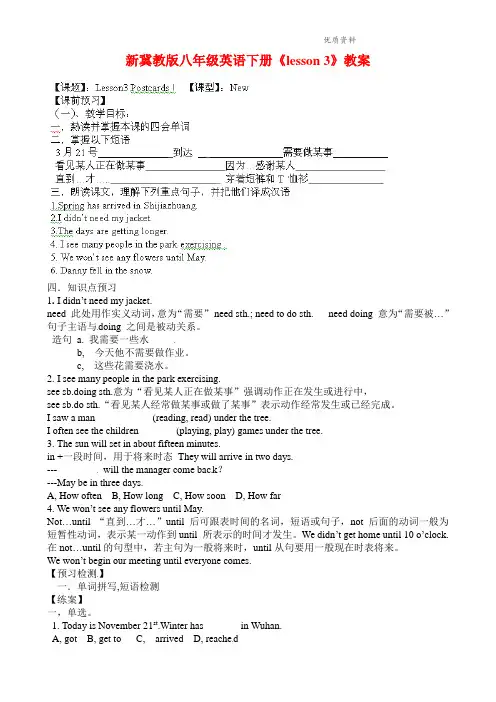
新冀教版八年级英语下册《lesson 3》教案四.知识点预习1. I didn’t need my jacket.need 此处用作实义动词,意为“需要”need sth.; need to do sth. need doing 意为“需要被…”句子主语与doing 之间是被动关系。
造句a. 我需要一些水__________________________b, 今天他不需要做作业。
_______________________c, 这些花需要浇水。
___________________________2. I see many people in the park exercising.see sb.doing sth.意为“看见某人正在做某事”强调动作正在发生或进行中,see sb.do sth.“看见某人经常做某事或做了某事”表示动作经常发生或已经完成。
I saw a man ___________(reading, read) under the tree.I often see the children _______(playing, play) games under the tree.3. The sun will set in about fifteen minutes.in +一段时间,用于将来时态They will arrive in two days.---________will the manager come bac k?---May be in three days.A, How often B, How long C, How soon D, How far4. We won’t see any flowers until May.Not…until “直到…才…”until 后可跟表时间的名词,短语或句子,not 后面的动词一般为短暂性动词,表示某一动作到until 所表示的时间才发生。
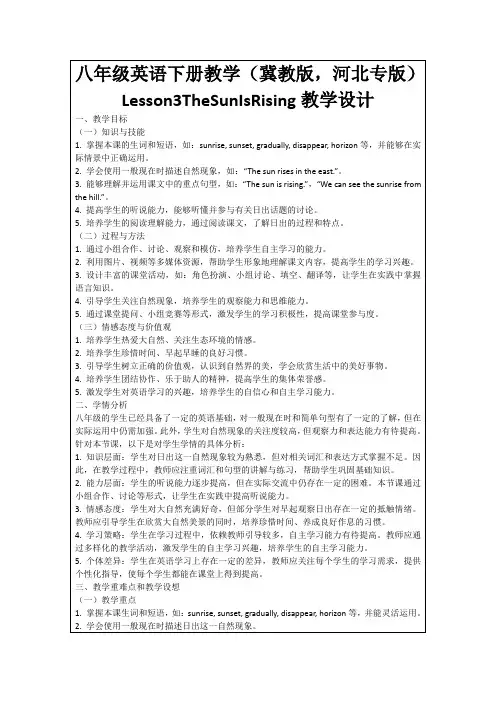
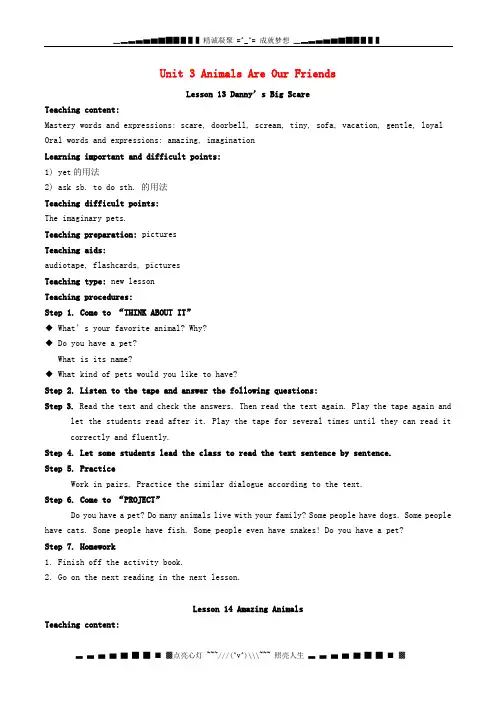
Unit 3 Animals Are Our FriendsLesson 13 Danny’s Big ScareTeaching content:Mastery words and expressions: scare, doorbell, scream, tiny, sofa, vacation, gentle, loyal Oral words and expressions: amazing, imaginationLearning important and difficult points:1) yet的用法2) ask sb. to do sth. 的用法Teaching difficult points:The imaginary pets.Teaching preparation: picturesTeaching aids:audiotape, flashcards, picturesTeaching type: new lessonTeaching procedures:Step 1. Come to “THINK ABOUT IT”◆ What’s your favorite animal? Why?◆ Do you have a pet?What is its name?◆ What kind of pets would you like to have?Step 2. Listen to the tape and answer the following questions:Step 3. Read the text and check the answers. Then read the text again. Play the tape again and let the students read after it. Play the tape for several times until they can read it correctly and fluently.Step 4. Let some students lead the class to read the text sentence by sentence.Step 5. PracticeWork in pairs. Practice the similar dialogue according to the text.Step 6. Come to “PROJECT”Do you have a pet? Do many animals live with your family? Some people have dogs. Some people have cats. Some people have fish. Some people even have snakes! Do you have a pet?Step 7. Homework1. Finish off the activity book.2. Go on the next reading in the next lesson.Lesson 14 Amazing AnimalsTeaching content:Oral words and expressions:long-eared, jerboa, mouse, kiwi, lay, eggplant, shake, flap, avoid Learning important and difficult points1) remind的用法2) lay的用法Teaching preparation: picturesTeaching aids:audiotape, flashcards, picturesType of lesson: new lessonTeaching procedures:Step 1. ReviewStep 2. Come to “THINK ABOUT IT.”◆ Can you name some animals you have never seen before?◆ What animals do you think are amazing? Why?Step 3. Read the text silently and ask the students to answer the following questions:Step 4. Play the tape and let the students read after it. Pause after every line, and ask the students to repeat.Step 5. Let some students read the text in class and the others listen to see if they have any mistakes. Can they find and correct the mistakes?Step 6. Let the students rewrite the story and read it to the class.Step 7. Discuss the reading with the students. Use as much English as possible. Ask questions to make it easier for students to participate.Step 8. HomeworkWould you like to have a pet?Why or why not?Write a paragraph.Lesson 15 The Zoo Is OpenTeaching content:Mastery words and expressions: danger, dangerous, mainly, bamboo, giraffeLearning important and difficult points:1.take photos2.nearly的用法Teaching preparation: picturesType of lesson: new lessonTeaching procedures:Step 1. Show some pictures of animals to the class. Ask the students:What animals do you like best?What animals can you see in the zoo?Step 2. Come to “THINK ABOUT IT.”▲ Have you ever been to the zoo?▲ What animals do you think are dangerous? Why?▲ What rules should we obey at the zoo?Step 3. Read the text.Step 4. PracticeStep 5. Read the text in roles. The teacher walks in the classroom while they are reading. Help them if necessary.Step 6. Let some students come to the front and act the dialogue out.Step 7. HomeworkPrepare the dialogue in group of three in “Let’s Do It”, and act it the next class.Lesson 16 The Bear Escaped!Teaching content:Mastery words and expressions: escape, fierce, protect, foolLearning important and difficult points:1.escape的用法2.if的用法3.wake upTeaching preparation: picturesTeaching aids:audiotape, flashcards, picturesType of lesson: new lessonTeaching procedures:Step 1. Free talkStep 2. Come to “THINK ABOUT IT.”★ When is April Fools’ Day?★ What do people do on that day?★ Have you ever played a trick on a friend? What did you do?Step 3. Listen to the tape and answer the questionsStep 4. Read the text and check the answers. Then let the students read it loudly in class. Aftera while, ask the students to act it out in front of the class.Step 5. Come to “LET’S DO IT”◆What do you think of the idea of April Fools’ Day?◆ Have you ever played a trick on someone? Share a trick with you partner.◆What do you think “ white lie” means?Step 7. HomeworkDo you know any other interesting foreign festivals?Write them down, and share with your partner next class.Lesson 17 Save the TigersTeaching content:Mastery words and expressions: century, fur, symbol, courage, brave, chain, balance, reason, disappear, kill, cut, decreaseLearning important and difficult points:1) the number of2) balance的用法3) danger的用法Teaching preparations: picturesTeaching aids:audiotape, flashcards, picturesTeaching procedures:Step 1. ReviewStep 2. Come to “THINK ABOUT IT.”Where can you usually see a tiger?Do you think tigers need our help? Why or why not?Step 3. Listen to the tape and repeat after it. Play the tape for several until they can read it correctly and fluently.Step 4. Let some students act the dialogue out in front of the class.Step 8. HomeworkWork in groups and discuss some ways we can protect animals. Write down your ideas.Lesson 18 Friendship Between AnimalsTeaching content:Mastery words and expressions: friendship, rhino, skin, warn, insect, relationship, survive, mzee, hippo, tortoise, truly, boundaryLearning important and difficult points:1) use的用法2) warn的用法Teaching preparation: picturesTeaching aids:audiotape, flashcards, picturesType of lesson: new lessonTeaching procedures:Step 1. Come to “THINK ABOUT IT”◆Do you think there is friendship between animals?◆ What different animals have you seen living well together?Step 2. Listen to the tape and let some students retell the main idea about the text. If they can’t do well, don’t publish them. Encourage them and say: “I know it is very difficult for you. It’s also difficult for me. Let’s face the problem together.”Step 3. Read the text silently and answer the questionsStep 4. ExerciseStep 5. HomeworkWhat will you do if you go to the zoo?Do you know anything that we cannot do in the zoo? Why?Think about it, and write a short paragraph.。
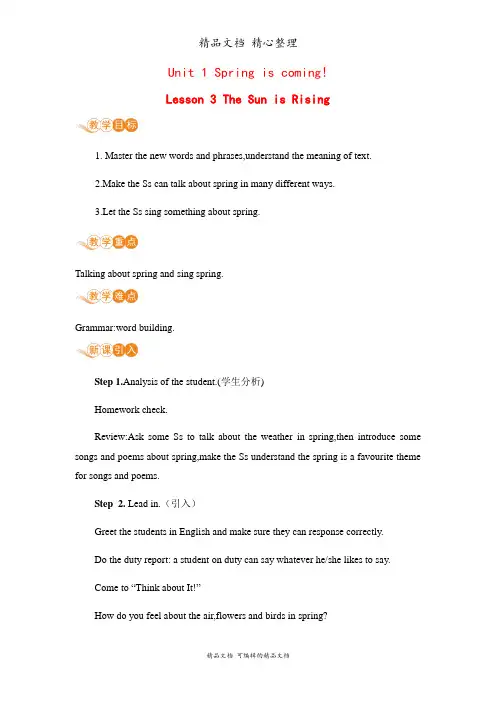
Unit 1 Spring is coming!Lesson 3 The Sun is Rising1. Master the new words and phrases,understand the meaning of text.2.Make the Ss can talk about spring in many different ways.3.Let the Ss sing something about spring.Talking about spring and sing spring.Grammar:word building.Step 1.Analysis of the student.(学生分析)Homework check.Review:Ask some Ss to talk about the weather in spring,then introduce some songs and poems about spring,make the Ss understand the spring is a favourite theme for songs and poems.Step 2. Lead in.(引入)Greet the students in English and make sure they can response correctly.Do the duty report: a student on duty can say whatever he/she likes to say.Come to “Think about It!”How do you feel about the air,flowers and birds in spring?Do you know any songs or poems about spring?Step 3. New lesson.(新课)No. 1 prepare lessons before class.Come to the vocabulary.Teach the new words and phrases.make sure the Ss can read it correctly.No. 2Text:Give them some time to read the text themselves. Then let them act out the dialogue in groups. Correct their pronunciation when necessary.At last,the teacher explain the text in Chinese,make sure the Ss can understand the meaning of text.No. 3 Look at this poem:Spring DawnSleeping lazily at dawn in spring,Sound of birdsong all around.Last night’s wind and rain still ring,How many blossoms blown to the ground?No. 4 Project:What do you like to do in spring?----outdoor activities.No. 5Grammar: word building.1.Review:复合词:Eg:thunderstorm sunrise sunset hometownsomething myself nobody somebody等等2.派生词:Eg:rain—rainy wind—windy cloud—cloudy snow—snowy lazy—lazily easy—easily day—dailyteach—teacher act—actor invent—inventionNo. 6Finish “Let’s Do It!”Step 4. Play the tape for the Ss to follow.Make the Ss listen the text,then let them read follow the tape.Finish the activity book and the practice.Copy the new words and phrases twice.。

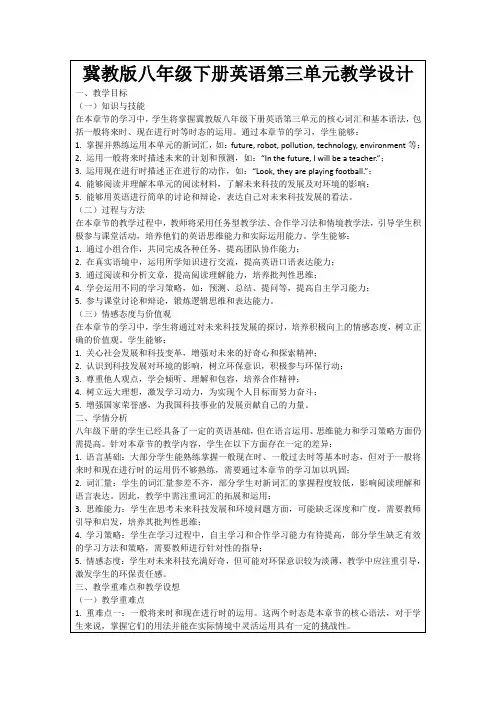
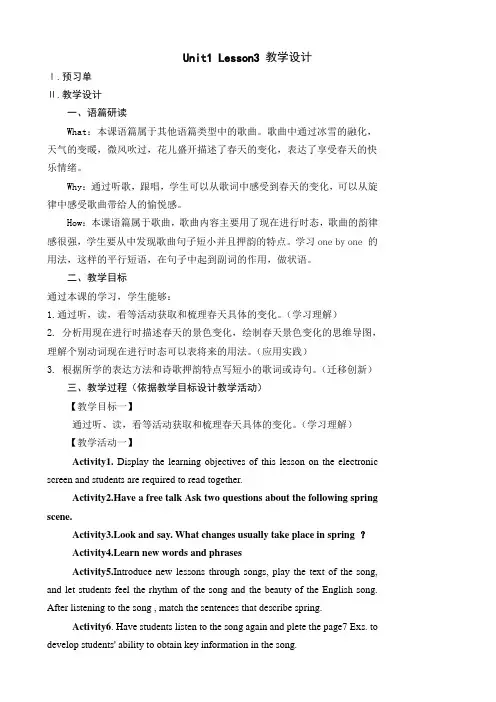
Unit1 Lesson3教学设计Ⅰ.预习单Ⅱ.教学设计一、语篇研读What:本课语篇属于其他语篇类型中的歌曲。
歌曲中通过冰雪的融化,天气的变暖,微风吹过,花儿盛开描述了春天的变化,表达了享受春天的快乐情绪。
Why:通过听歌,跟唱,学生可以从歌词中感受到春天的变化,可以从旋律中感受歌曲带给人的愉悦感。
How:本课语篇属于歌曲,歌曲内容主要用了现在进行时态,歌曲的韵律感很强,学生要从中发现歌曲句子短小并且押韵的特点。
学习one by one 的用法,这样的平行短语,在句子中起到副词的作用,做状语。
二、教学目标通过本课的学习,学生能够:1.通过听,读,看等活动获取和梳理春天具体的变化。
(学习理解)2. 分析用现在进行时描述春天的景色变化,绘制春天景色变化的思维导图,理解个别动词现在进行时态可以表将来的用法。
(应用实践)3. 根据所学的表达方法和诗歌押韵特点写短小的歌词或诗句。
(迁移创新)三、教学过程(依据教学目标设计教学活动)【教学目标一】通过听、读,看等活动获取和梳理春天具体的变化。
(学习理解)【教学活动一】Activity1.Display the learning objectives of this lesson on the electronic screen and students are required to read together.Activity2.Have a free talk Ask two questions about the following spring scene.Activity3.Look and say. What changes usually take place in spring ?Activity4.Learn new words and phrasesActivity5.Introduce new lessons through songs, play the text of the song, and let students feel the rhythm of the song and the beauty of the English song. After listening to the song , match the sentences that describe spring.Activity6. Have students listen to the song again and plete the page7 Exs. to develop students' ability to obtain key information in the song.【效果评价一】观察学生回答问题的表现,根据说出的具体单词和短语,了解其关于问题表述的词汇储备。
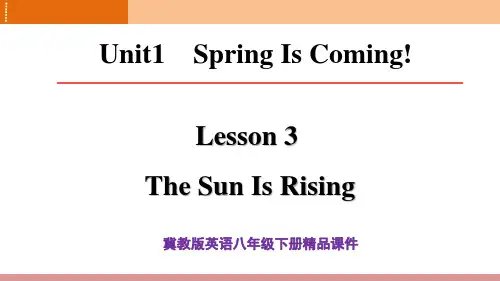

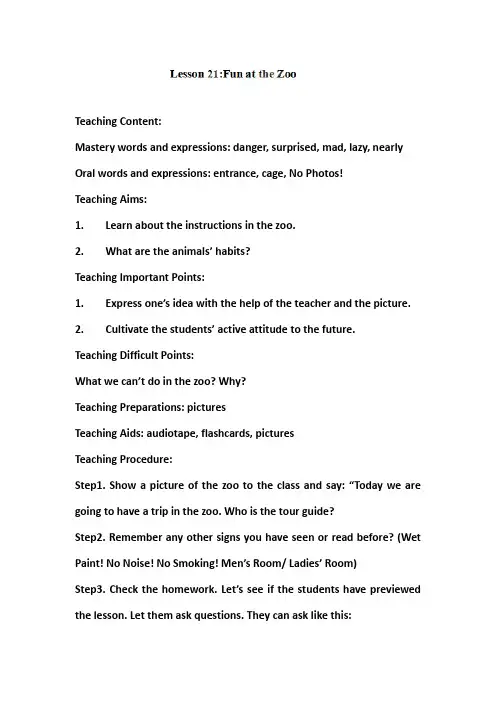
Teaching Content:Mastery words and expressions: danger, surprised, mad, lazy, nearly Oral words and expressions: entrance, cage, No Photos!Teaching Aims:1. Learn about the instructions in the zoo.2. What are the animals’ habits?Teaching Important Points:1. Express one’s idea with the help of the teacher and the picture.2. Cultivate the students’ active attitude to the future.Teaching Difficult Points:What we can’t do in the zoo? Why?Teaching Preparations: picturesTeaching Aids: audiotape, flashcards, picturesTeaching Procedure:Step1. Show a picture of the zoo to the class and say: “Today we are going to have a trip in the zoo. Who is the tour guide?Step2. Remember any other signs you have seen or read before? (Wet Pai nt! No Noise! No Smoking! Men’s Room/ Ladies’ Room)Step3. Check the homework. Let’s see if the students have previewed the lesson. Let them ask questions. They can ask like this:1. When is the zoo open?2. What do we can’t do in the zoo?3. Why can’t we take photos?4. What animal would Danny like to make friends with?Step4. Listen to the tape and repeat after it. Play the tape for several until they can read it correctly and fluently.Step5. Read the text in roles. Then change the roles each other. Help them during their reading.Step6. Let some students act the dialogue out in front of the class. Step7. Come to “LET’S DO IT”.In a group of three, act out a trip to the zoo. Each group member takes one of the three roles (Brain, Jenny or Danny). Try changing the story. Be creative.Give the students time. Then let them act it out. Choose which group is the most creative.Step8. Homework1. Finish off the activity book.2. Go on the next reading in the student book.Summary:When we practice spoken English like step7 “LET’S DO IT”. Remember to give chance to the poor students. Encourage them to speak loudly in class. Praise them when they have some progress. Encourage others tohelp them in many ways to cultivate their confidence。

冀教版英语八年级下册第三单元教案Lesson 17: People Love PetsTeaching Content:Mastery words and expressions: pet, keepOral words and expressions: amazing, imaginationTeaching Aims:1.Animals play an important part in our life.2.Practice the students’ spo ken English.Teaching Important Points:1.Reminding and Warning.2.Grasp the key words in the listening.Teaching Difficult Points:The imaginary petsTeaching Preparation: picturesTeaching Aids: audiotape, flashcards, picturesTeaching Type: new lessonTeaching Procedure:Step1. Come to “THINK ABOUT IT”.1.What’s your favourite animal? Why?2.Do you have a pet? Would you like to have one?Discuss the questions in groups with three or four people. Then report to the class.Lets’ have an interview. How many students in your class like cats? How many students in your class like dogs? Does anyone in your class have strange pet? Why do you think it is strange?Step2. Listen to the tape and answer the following questions:1.Does Jenny have a pet? What is it?2.What animal would Danny like to have for a pet?3.What animal would Brain like to have for a pet?Step3. Read the text and check the answers. Then read the text again. Play the tape again and let the students read after it. Play the tape for several times until they can read it correctly and fluently.Step4. Let some students lead the class to read the text sentence by sentence.Step5.PracticeWork in pairs. Practice the similar dialogue according to the text. Step6. Come to “PROJECT”.Do you have a pet? Do any animals live with your family?Describe your pet, or describe a pet you would like to have. Write a passage about your pet or your imaginary pet. Draw a picture to match it. Then put them on the wall.Divide the class into several groups. Let them give a report to the class. If you can’t finish the project in one lesson, go on it the next lesson. Step7. Homework1.Finish off the activity book.2.Go on the next reading in the next lesson.Summary:Dogs are people’s friends in the life. They are very important in many ways. We hear many stories that the animals save the owners out of danger. We must give love to the animals and we must love each other.Lesson 18: Brandy Hates CatsTeaching Content:Oral words and expressions: Brandy, chase, squirrel, branch, fierce, Amy Teaching Aims:1.Understand the main parts of a story.2.Describe one’s experience with the help of the pictures. Teaching Important Points;1.The Past Continue Tense.2.Express one’s ideas in English.Teaching Difficult Points:The Past Continue TenseTeaching Preparation: picturesTeaching Aids: audiotape, flashcards, picturesType of lesson: new lessonTeaching Procedure:Step1. Show the picture of Mike and the dog to the class. What does the passage describe according to the picture? Let the students to express theirs ideas in English.Step2. Come to ‘THINK ABOUT IT.”Step3. Read the test silently and ask the students to answer the following questions:1.What’s the name of the dog?2.Does the animals need love? What do we do?3.What does Brandy like to do when we are walking?4.What are sticks?5.Is Brandy fierce? What is she scared of?Step4. Play the tape and let the students read after it. Pause after every line, and ask the students to repeat.Step5. Let some students read the text in class and the others listen to see if they have any mistakes. Can they find and correct the mistakes? Step6. Let the students rewrite the story and read it to the class.Step7. Discuss the reading with the students. Use as much English as possible. Ask questions to make it easier for students to participate. Ask questions like this:What does Mike do to look after his dog?Lots of people in North America have pets. In this way, are people in North America the same as, or different from, people in China?Step8. Homework1.Finish off the activity book.2.Review the next lesson.SummaryIt’s easy and interesting for the students to talk about the familiar dialogues in English. Give them chance to practice in class. They can prepare before the class, too. Some students need more time. If they don’t have a real one, what animals do they really want to have?Lesson 19: Brandy Hates Cats!Teaching Content:Mastery words and expressions: open, somewhere, lake, all kinds of, protect, scientistOral words and expressions: extinct, gorilla, protect…from…, go extinct, stop…from doingTeaching Aims:1.Ask the people to protect animals.2.What are the zoos for?Teaching Important Points:1.What will we take if we go to a zoo?2.Write a story about a trip to the zoo.Teaching Difficult Points:Some words and expressionsTeaching Preparation: picturesType of lesson: new lessonTeaching Procedure:Step1. Show some pictures of animals to the class. Ask the students: What animals do you like best?What animals can you see in the zoo?Step2. Read the text and let the students repeat the main ideas of the text.Step3. Listen to the tape, pause after every line, and ask the students to repeat (a) in chorus, (b) in small groups, (c) individually.Step4. PracticeDeal with the vocabulary. Select one or two words for discussion. For example, the word kind can be used as an adjective (Mr. Smith is a kind person) or a noun (I like this kind of pet). The word open can be used as a verb (Open the door) and an adjective (The door is open). Can students think of other examples? You may want to compare zoo with school. Remind the students that while we say, “ go to school” (here the word the is not used), we usually say “go to the zoo”(here the word the must be used). Step5. Read the text in roles. The teacher walks in the classroom while they are reading. Help them if necessary.Step6. Let some students come to the front and act the dialogue out. Step7. Come to “PROJECT 2”Divide the class into several groups and finish the task.Instruct the students to write a story about a trip to the zoo they have taken or would like to take. The story can be real or imaginary. They should illustrate their stories with pictures or photographs. Students may continue working on their stories during the next two lessons.Step8. Homework1.The third reading in the reader.2.Finish off the activity book.Summary:It is important for us to protect animals from extinction. Let the students look up after class about the information about the animals. How many animals are there in the world? Now how many kinds of animals have been extincted? What do we need to do immediately? What have our government done for this? What’s your opinion about this? Can you give some good advice?Lesson 20: Stand So StillTeaching Content:Mastery words and expressions: still, make friends with, while, camel, fear, shy, bearOral words and expressions: waddle, toss, sealTeaching Aims:1.Continue animals as our friends.2.Learn about the foreign culture.Teaching Important Points:1.How do you make friends with animals?2.What are the animals’ habits?Teaching Difficult Points:Make friends with animalsTeaching Preparation: picturesTeaching Aids: audiotape, flashcards, picturesType of lesson: new lessonTeaching Procedure;Step1. Free TalkTalk about your trip to a zoo. Work in groups. Write a passage and report it to the class. You can answer the following questions:1.Where did you go?2.How did you go”3.What’s the weather like that day?4.What did you do in the zoo?5.Where did you have lunch?6.Where did you have a rest?Step2. Listen to the tape and repeat after it. Let us lose ourselves in the beautiful music now.Help the students to guess the meaning of the new words that appear in the text. This will in turn help the class understand the meaning of the song.Step3. Listen to the tape and answer the following questions:1.How do you make friends with the animals? Why?2.What does Danny like to do?3.What animal would he like to make friends with?4.Do you think what animals are fierce?Step4. Read the text and check the answers. Then let the students read it loudly in class. After a while, ask the students to act it out in front of the class.Step5. Make sure everybody can sing confidently. Let volunteers come to the front and sing loudly.Step6. Come to “LET’S DO IT”.Work in groups and give their opinions in class. Encourage them to speak freely. Maybe they will have good advice. You can write a letter and show your opinions to the local government.Step7. Homework1.Finish off the activity book.2.Review the next lesson.Summary:Let the students draw a picture of you and your favourite animal. Put them up on the wall. According to the content of today, we can practice spoken English about a trip to a zoo. Make up a dialogue in two or three and act it out in front of the class.Lesson 21:Fun at the ZooTeaching Content:Mastery words and expressions: danger, surprised, mad, lazy, nearly Oral words and expressions: entrance, cage, No Photos!Teaching Aims:1.Learn about the instructions in the zoo.2.What are the animals’ habits?Teaching Important Points:1.Express one’s idea with the help of the teacher and the picture.2.Cultivate the st udents’ active attitude to the future.Teaching Difficult Points:What we can’t do in the zoo? Why?Teaching Preparations: picturesTeaching Aids: audiotape, flashcards, picturesTeaching Procedure:Step1. Show a picture of the zoo to the class and say: “T oday we are going to have a trip in the zoo. Who is the tour guide?Step2. Remember any other signs you have seen or read before? (Wet Paint! No Noise! No Smoking! Men’s Room/ Ladies’ Room)Step3. Check the homework. Let’s see if the students have preview ed the lesson. Let them ask questions. They can ask like this:1.When is the zoo open?2.What do we can’t do in the zoo?3.Why can’t we take photos?4.What animal would Danny like to make friends with?Step4. Listen to the tape and repeat after it. Play the tape for several until they can read it correctly and fluently.Step5. Read the text in roles. Then change the roles each other. Help them during their reading.Step6. Let some students act the dialogue out in front of the class. Step7. Come to “LET’S DO IT”.In a group of three, act out a trip to the zoo. Each group member takes one of the three roles (Brain, Jenny or Danny). Try changing the story. Be creative.Give the students time. Then let them act it out. Choose which group is the most creative.Step8. Homework1.Finish off the activity book.2.Go on the next reading in the student book.Summary:When we practice spoken English like step7 “LET’S DO IT”. Remember to give chance to the poor students. Encourage them to speak loudly in class. Praise them when they have some progress. Encourage others to help them in many ways to cultivate their confidenceLesson 22: April Fools’Teaching Content:Mastery words and expressions: joke, yourselvesOral word s and expressions: fool, trick, April Fools’, play joke on…Teaching Aims:1.Learn about the foreign culture in western countries.2.What are the main festivals in western countries?Teaching Important Points:1.Learn about the things that we can do in April Fools’.2.What we usually in China on April Fools’?Teaching Difficult Points:the main festivals in western countriesTeaching Preparation: picturesTeaching Aids: audiotape, flashcards, picturesType of lesson: new lessonTeaching Procedure:Step1. Come to “THINK ABOUT IT”.Explain April Fools’ Day in English. Let’s see how many students can understand you. Tell them what they usually do on that day.Step2. If happens today is April Fools’, play a joke on the students. When the teacher comes into the classroom, says we will have a quiz today. The students may feel surprised and puzzled, why didn’t the teacher tell them earlier? When they all in a hurry, tell them we only play a joke on them. Now they can understand the festival clearly.Step3. Listen to the tape and let some students retell the main idea about the text. If they can’t do well, don’t publish them. Encourage them and say: “I know it is very difficult for you. It’s also difficult for me. Let’s face the problem together.”Step4. Read the text silently and answer the following questions:1.What is the date today?2.What’s the meaning of April Fools’ Day?3.What do they decide to do?4.Did Danny believe what Brain and Jenny said?Step5. Listen to the tape for several times until they can read it correctly and fluently.Step6. Let some students read the text in roles. Then change the roles. Now let’s briefly discuss the reading. To dertermine students’ level of understanding, ask them to ask questions about the text. They may begin like this:1.What did Brain and Jenny want to do?2.Did the bear get out of the zoo?3.Was the cage open?4.Who said the bear looked hungry?5.What did Danny say on Saturday?Step7. Let some students act the dialogue out in front of the class. Step8. Homework1.Finish off the activity book.2.Go on the next reading in the student book.Summary:Listening is a difficult part in English teaching. So teaching the stude nts how to improve one’s listening ability is very important. We can use many types in class. The main types are: listen and answer the following questions; listen and fill in the blanks; listen and choose the best answer; listen and repeat the main idea about the story. Of course, the last one is the most difficult. The teacher should practice the students listening ability step by step.Lesson 23: Famous ZoosTeaching Content:Mastery words and expressions: giraffe, AsianOral words and expressions: Egypt, Africa, pyramid, Italy, wedding, Siberian, be famous forTeaching Aims:1.Know about the history of the zoo.2.Call on people all over the world to create a more life for theanimals.Teaching Important Points:1.Learn about the growth of the zoo.2.Improve the students’ reading ability.Teaching Difficult Points:Some words and expressions: Egypt, Africa, Italy, Siberian, be famous for Teaching Preparation: picturesTeaching Aids: audiotape, flashcards, picturesType of lesson: new lessonTeaching Procedure:Step1. Deal with the words first because the words in this lesson are a little difficult. Let some students read the words. Then read after the teacher. After several times, let some students read the words and the others read after it. Now close the cooks, let some students read the words in class, at the same time, the others read after it.Step2. Listen to the tape and fill in the blanks:1.One of the world’s first zoos was in ______, about ________ yearsago.2.Egypt is a country in _______.3.China built its zoo about _______ years ago.4.________ years ago, a king kept many wild animals in his zoo.5.When he got married, he took _______, _______, ________ and ________to his wedding.6.One hundred years ago, a new kind of zoo opened in _______. Step3. Read the text and briefly discuss the reading. To determine students’ level of understanding, ask questions like this:1.When the first zoos built in Egypt?2.What people can go to the zoo?3.Where is Egypt? What is it famous for?4.When did China build its first zoo?5.Were there animals in wedding clothes eight hundred years ago? Whatdid they do?6.Where did a new kind of zoo open one hundred years ago?Step4.Listen to the tape again and repeat after it until they can repeat it correctly and fluently. Let some students read the text in class. Choose the best one to encourage from the students’ pronunciation and intonation.Step5. Ask the students what they know about the history of the zoo. Encourage them to search on the Internet and report to the class in next class.Step6. Come to “LET’S DO IT”.Divide the class into several groups and discuss the task. What are the good ways for animals living in the zoos? What are the bad ways? Let the students give them advice freely.Animals should have a better life. But what can we do? Can the students give more good advice? Report to the class and discuss together.Step7. Homework1.Finish off the activity book.2.Go on the next reading in the students’ book.SummaryEveryone does not know the history of zoos. In order to get more information, we can use the Internet and the time after class to enlarge the knowledge. Then the teacher give them chance to show their performance to the class.Lesson 24: Unit ReviewTeaching Content:Mastery words and expressions from Lesson 17 to Lesson 23.Oral words and expressions from Lesson 17 to Lesson 23.Teaching Aims:1.Teach people to love life, animals and environment.2.How can we make a better life for the animals?Teaching Important Points:1. Learn about the festivals in western countries.2.Teach the students the ways of learning by themselves.Teaching Difficult Points:The Past Continue TenseTeaching Preparation: picturesTeaching Aids: audiotape, flashcards, picturesType of lesson: review lessonTeaching Procedure:Step1. Let some students come to the front and sum the main content that we learn in this unit.The teache r helps him when he has difficulties. If one can’t say clearly, the others can add it.Step2. Ask the students to review the grammars that we learn in this unit. Provide help if it necessary. If one student can’t finish it, the others can go on.Step3. Make up sentences with the important words and expressions that we learn in this unit. Such as: protect…from… be famous for. The teacher can arrange an order, according to the time or the length.Step4. Talk about the favourite animals. Divide the class into several groups and share the pleasure that the animals bring you.Step5. Do the exercises on Page 29. The teacher walks around the classroom and provides help when they are in trouble.Step6. Explain some problems on the blackboard. Let’s discuss together. Practice “Speaking the Language” in class.Step7. Let’s sing the song, if we have time.Step8. Homework1. Finish off the activity book.2.Sum what we learn in this unit.Summary:The content in this unit is very familiar to the students. Give them more chance to practice in class. Let them search on the Internet for the further information. Teach them the ideas of learning by themselves, which is very important to the students’ learning in the future.。
Lesson 3: : The Sun Is Rising(two periods)教案Teaching Content:Mastery words and expressions: one by one, changeOral words and expressions: hillside, gently, blossomTeaching Aim:Enjoy the beauty of the springTeaching Important Point:Grasp the changes that spring bring usTeaching Difficult Points:How to use “warm” and “gently”.Teaching Preparation: something that represents springTeaching Aids: audiotape, flashcards, pictures or flowersType of lesson: new lessonTeaching Procedure:一、温故知新。
Check some words and phrases .二、激情导入。
Lead inFree Talk:Let the students work in three and talk about the sports that we often do in spring. Then give a talk for the class.三、新课学习。
Step 1: Showing the teaching aims on the blackboard and asking students to read them together.1.Remembering some new words and phrases of lesson 3 work in group.2.Talking about seasons.3.Understanding the dialogue meaning.Step 2:Read the song aloud as a poem. This song has this song has common English words: come with me, through the trees, one by one, the flowers blossom. Translate these expressions into English.Step3. Play the audiotape and let the students just listen with the eye closed.Step4. Play the tape again and let the students sing with it.Step5. Explain the common English expressions.Step6. Practice the song a few times, with and without the audiotape. Step7. Come to “LET’S DO IT”.四、达标训练,作业布置。
Lesson 8: Unit Review单元复习◆课文英汉对照Ⅰ. Building Your Vocabulary 增强你的词汇A. Fill in each blank with the proper word from the list. Use the correct form. 从方框中选出合适的词,并用其正确形式填空。
need需要hold握住kick踢set 落下get 变得1. Days __________ longer in spring.白天在春天__________长了。
.2. When we play soccer, we __________ the ball.我们踢足球时,我们__________球。
3. It’s still cold. I _________ my jacket and boots.还是很冷,我__________我的夹克和靴子。
4. The sun _________ in the evening.太阳在傍晚__________。
5. Please _________ the swing for me.i want to climb down.请为我_________秋千,我想爬下来。
答案:1. get2. kick3. need4. sets5. holdB. Find the proper words in this unit.从本单元中找出合适的词。
1. the opposite of pull: __________“拉”的反义词:_____________2. a short- lasting fall of rain: __________持续时间不长的降雨:_____________3. something that is true or real: __________一件真的、不捏造的事:_____________4. way from one place to another, where cars, buses can drive: __________从一处到另一处,小汽车、公共汽车可以在上面行驶的路:_____________5. a piece of ground where children play in a school: __________孩子们在学校玩耍的一块场地:___________C. Fill in the blank with the proper word. The first letter is given. 用合适的单词填空,首字母已给出。
Unit 3 Amazing Animals个案修订设计人:高娟I、Knowledge aims:(1)The past continuous Tense.(2)Reminding and warningII、Ability aims:Let students describe their pets and write an articleabout animals.III、Moral aims:Encourage students to love pets and protect them.IV、Important pointsHe was talking to my mother when I got home.Were you playing soccer at nine o’clockyesterday morning?all kinds of, be famous for…make friends wit h, protect/ stop…from ,run away slow downV、Difficult points(1)Reminding and warning(2)The past continuous Tense.VI、Teaching methods:Seven steps teaching methodsVII、Teaching tools.A tape recorder a blackboardLesson 17: People love pets!Period One (第一课时) -----年 -----月-----日I. Teaching aims(教学目标)1. Knowledge aims:(知识目标)个案修订Key words: pet; keep; lovely;amazing; imaginary…Key phrases: real pets; imaginary pets;Sleep in the sun: go with…;Key sentences: 1)She plays with me when I comehome from school.2) I will need to plant a tree in my bedroom!2. Ability aims:(能力目标)The students can use the key words ,phrase to make up sentences as morepossible as they can by themselves.3. Moral aims:(情感目标)Let the students love nature.Learn more about the agriculture.II. Important points (重点)Key words ,phrase and sentences.III. Difficult points(难点)Make each students master these key words ,phrase and sentences.IV. Teaching proceduresWarming upAsk some students to have a free talk .Step 1. Showing teaching aims(students read together)(出示目标)I. Teaching aims(教学目标)1. Knowledge aims:(知识目标)Key words: pet; keep; lovely;个案修订amazing; imaginary…Key phrases: real pets; imaginary pets;Sleep in the sun: go with…;Key sentences: 1)She plays with me when Icome home from school.2) I will need to plant a tree in my bedroom!Ability aimsThe students can use the key words,phrases to make up sentences as morepossible as they can by themselves.Step2: Raising the questions.What is Jenny going to write?(1)Where does Snowball like to sleep?(2)When does Snowball play with Jenny?(3)What will Danny's pet be?(4)What animal would Brain like to have for a pet?Step3: Preparing to answer the questions. above bythemselves.Step4: Acting in groupsStep5: Listening to the tape.(Let students correct their pronunciation)Step6: Finding out the difficult points(Teachers Can help students to find them out)1.I'm going to write about my cat.2.play with sb3.take…to…4.plant a tree5.keepStep7: Homework:1.remember the new words.2.study the difficult points by your reference books Bb Design1)take…to…把……带到……(表示把某物/某人)从说话人所在地带走2)bring…to…把……带到/带给……指把某人/物带到说话所在地eg: Please take the boy home.3)plant a tree 植树 eg:We often plant a tree in spring. 4)keep V. 保留饲养保存某物使…处于某种状态eg: keep a seat for me, will you?课后反思:Lesson 17: People love pets!Period Two (第二课时) - --年----月----日I.Teaching aims(教学目标)I. Teaching aims(教学目标)1. Knowledge aims:(知识目标)Key words: pet; keep; lovely;amazing; imaginary…Key phrases: real pets; imaginary pets;Sleep in the sun: go with…;Key sentences: 1)She plays with me when I comehome from school.2) I will need to plant a tree in my bedroom!2. Ability aims:(能力目标)The students can use the key words ,phrase to make up sentences as morepossible as they can by themselves.个案修订II. Important points (重点)Key words ,phrase and sentences.III. Difficult points(难点)Make each students master these key words ,phrase and sentences.IV. Teaching proceduresWarming upAsk one of the students to have a free talk.Step 1 Showing teaching aims(students read together) (出示目标)Step2: Explain the main points by students in groups(1) I'm going to write about my catbe going to +V. 表示打算或计划做某事某人做主语,表示事先安排要做某事,某物做主语,表示事情将要发生eg:Ma Li is going tobuy a new computerwrite about sb/sth 描写有关某人或某物的情况(2) play with sb/sth 与某人/某物一起玩play with sth 玩弄、耍弄Don’t play with fire. It’s dangerousStep3: Developing the knowledge.She plays with me when I come home from school.此句为时间状语从句,时间状语从句常由when(当……的时候)as…while…before(在……之前)after(在……之后)as soon as (……就)since…(自从……)until/till(直到……)等引导,在时间状语从句中主句是将来时从句要用一般现在时表示将来。
Unit 8 Save Our World!教案Lesson 43 Let’s Clean Up!Learning aims:1. Let the students understand to protect our environment is our duty.2. We should keep our school yard clean.Learning important points:1. Know how many ways we can say “garbage”.2. Talk about the destroy of the rubbish.Learning tools:audiotape, flashcards, picturesLearning steps:Step 1. Leading inShow the new words to the students. Let the students read the words first. Then let them read after the tape.Step 2. ListeningStep 3. ReadingRead the text and check the answers silently. At the same time, answer the following questions:1. Where are Jenny, Brian and Danny?2. How’s the weather?3. What do English people call “rubbish”?4. What is Jenny studying in class this week?5. What does the teacher think of Jenny’s idea?Step 4. Read the text in roles loudly. Then let some students act it out in front of the class.Step 5. PracticeStep 6. HomeworkListen to the text and read it again.Finish off the activity book.Write about the garbage you make everyday.Lesson 44 Environment ClubsLearning aims:1. This lesson focuses on the environment issues.2. It presents some solutions to the problems that pollutio n p oses.Learning important points:1. It presents thought-provoking facts and figures abut pollution in North America.2. Call on the students to take personal action to reduce pollution.Learning tools:audiotape, flashcards, picturesLearning steps:Step 1. Leading inStep 2. ReadingRead the song as a lyric poem. Let the students read after you. Then let them read and translate it. They must add their feelings in it.Step 3. Come to “Think About It”●What can you do to stop pollution?●What do you do when you see someone throw garbage on the ground?Step 4. Ask some volunteers to come to the front and act it out.Step 5. PracticeWork in groups of three or four. Give examples of the things that we can do around us.Discuss and give a report to the class.Lesson 45 Let’s Sort Garbage!Learning aims:1. Master the new words and expressions: sort, metal, weight, percent2. Call on the students to take actions to protect our environment.3. Learn about the pollution problems in our life.Learning important points:1. Offering help.2. Learn new vocabulary for describing materials and for comparing qualities.Learning tools:audiotape, flashcards, picturesLearning steps:Step 1. Remind the students:1. What kinds of rubbish do you throw every day? Can you name them?2. What can be recycled?Step 2. Work in groupsLet the students go to the dustbin to collect some garbage and take them to the classroom.Ask the students name them and compare the qualities.Let the students look up the books and the dictionaries when they are in trouble. Help them when they can’t express correctly.Step 3. ListeningListen to the tape finish Exercise 2 in the activity book.1. Every year, each person in North America makes about 1000 kilograms of garbage.2. Plastic makes the most garbage.3. In just one day, Americans throw out 136 million kilograms of packaging.4. Packaging makes the most garbage.Step 4. ReadingRead the text and check the answers.Let the students read the text in roles. Then ask several students to act out the dialogue.Step 5. Come to “PROJECT”Bring the students to pick up the garbage in the school yard. Put the garbage into bags and bring it to school for our project.Take a walk around your neighbourhood, take a bag with you and pick up any garbage you see. Wear gloves, because garbage in dirty.Now sort the garbage into paper, plastic, metal, glass and others.Then compare the garbage in school yard with that in neighbourhood.Have students work in the same groups or in new groups. Each group will make a poster about what things they can do to help reduce pollution in the world.Lesson 46 Protect Our EnviormentLearning aims:Know about the pollution in our country.We all should take care of our environment.Learning important points:How do you think the pollution in our country?What should we do to stop pollution?Learning tools:audiotape, flashcards, picturesLearning steps:Step 1. Come to “THINK ABOUT IT.”How often do you take a shower?Why should we take short showers?What can you do to save water?Step 2. Show the new words to the class. First let them read them by themselves. Then read them after the teacher. Practice the words for a while.Step 3. Let’s Do ItWhat good things has Katie done for the environment?Do you feel the same or different about the environment as Katie? Why?Step 4. ListeningStep 5. ReadingRead the text in silence. Check the answers. Then let the students read the text in class loudly.Step 6. DiscussionLesson 47 Connected to NatureLearning aims:Call on the students to take actions to protect our environment.Learn about the pollution problems in our life.Learning important points:Offering help.Learn new vocabulary for describing materials and for comparing qualities.Describe materials and comparing qualities.Learning difficult points:The words and expressionsLearning tools:audiotape, flashcards, picturesLearning steps:Step 1. ListeningStep 2. Play the tape againLet the students read after it for several times. Ask the students to read the text loudly in class.Step 3. PracticeStep 4. Come to “LET’S DO IT!”Step 5. Homework1. Finish off the activity book.2. Go on the next reading in the student book.Lesson 48 Garbage Is Interesting!Learning aims:1. Master the new words and expressions: used, divide, pile, seat, lid, ton, duty2. Call on the students to protect the environment.3. Think about many ways to reduce pollution.Learning important points:1. Sum what we learn in this unit.2. Learn the knowledge of protecting environment.Learning tools:audiotape, flashcards, picturesLearning steps:Step 1. Leading-inHow do people do with the collected rubbish?Step 2. Come to “Think About It”What kinds of things can be recycled and reused?Step 3. ReadingStep 4. DiscussionAnalyze the text with the students. Discuss the main idea of this text. Let the students sum some language points and practice in class.Step 5. Ask the students show what they have make out of the garbage. Present them to the class.Explain to the students how they work. Demonstrate in the class.Step 6. TalkingTalk about what you feel about our environment. After they learn the text, what do they want to do? What are they doing these days?。
2021年八年级英语下册 Unit3 Lesson18教案冀教版
Lesson18 Brandy Hates Cats!
?Step1:复习巩固、激情导入
复习:提问Lesson17知识点1-3
导入:What would you like to have as a pet?
?Step2:出示目标、明确任务
1.牢记本课黑体词汇:branch/chase等;
2.熟读课文,把握其意;
3.背诵重点句子1-5,并灵活运用相关知识点。
?Step3:自主学习、合作探究
任务一:限时3分钟,熟读所有词汇,牢记黑体词汇
任务二:熟读课文,把握其意,画出不理解处,同桌之间交流
任务三:背诵重点句子,并自学知识点,画出不理解处,同桌之间交流
1.My dad was going to cook them for supper.
2.He was talking to my mum.
3.I can't remember what we had for supper that night.
4.That's why we take Brandy for a walk every day.
5.Slow down!
?Step4:师生互动、展示提升
互动一:单词记忆比赛
互动二:课文郎读接力赛
互动三:知识点展示大比拼
知识点一:He was talking to my mum.
was\were+doing是过去进行时,表示在过去某一时刻正在进行的动作。
Eg: He wasn't watching the hamburgers at that time.
He was cooking supper when I got home. .
知识点二:I can't remember what we had for supper that night.
【辨析】“forget to do sth。
”表示将来不要忘记做某事,谈的是未来的事情;
“forget doing sth。
”表示忘记过去应该做的事情。
Eg:“Don't forget to do your homework。
” said the teacher before the class was over. 老师在下课前说:“不要忘记做家庭作业。
”
“I'm sorry. I forgot doing my homework. May I hand it in this afternoon, Mr. Chen?” said Li Ming. 李明说:“对不起,我忘记做家庭作业了。
我今天下午交好吗,陈老师?”。
知识点三:That's why we take Brandy for a walk every day.
划线部分是一个由why引导的表语从句。
知识点四:Slow down!
Slow down是固定词组,意为“慢下来”,指放慢速度;
反义短语为:speed up,意为“加速”
?Step5:巩固练习、检测验收
教学反思:^" 32480 7EE0 绠32564 7F34 缴t ;S26760 6888 梈39539 9A73 驳 35605 8B15 謕k38284 958C 閌。